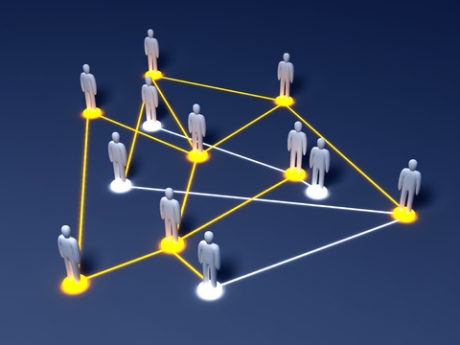Social network classified

Social networks can be classified into 7 categories based on their purposes:
- Love and dating networks
- Friendship networks
- Business networks
- Job and Talent networks
- Communities (based on branding and companies, groups and fan clubs) and Knowledge networks
- Games networks
- Virtual worlds
The first kind of networks are Love and dating networks were amongst the first kind of online networks such as “meetic” or “Date.com” . It allowed users to find their matching in love. It was directly followed by more adult sites such as “Adult finder”. Love sites were immediately accepted by the public due a lack of social behaviour of urban youth. Millions of people around the world registered to those dating sites in order to find their love mate. According to Gartner, this sites are came into a mature fase in 2004.Today must of the people tend to seek their future love mate through Facebook or myspace were you have a broad view of the personality of the person you try to contact, sort of “tell me how are your friends and I tell you who you are”
Dating sites does not give a clear view of the person behind the profile thus the person can enter a false identity or even lie about his characteristics.
The second kind of networks who followed closely and logically the dating sites are “friendship networks” . The first to emerge were Classmates in 1995 and Friendster. Both are still found on the web besides being surpassed by younger social networks such as Myspace, Netlog or Facebook. Mainly due to the lack of a Multilanguage platform, but also from funny applications and friendly graphical structure. Myspace is considered to be a revolution in social networks and are considered to be the MTV of the web because musical talent can be discovered. Indeed Myspace is for the web what MTV was in the eighties in the music industry, Deejays, Musicians, singers and others gather together to share talent and promote talent. Must of this friendships sites started with students and developed into a more mature fase, first because those same students became part of the work system but also they spread the word and the trend (Facebook phenomenon). One thing in particular became clear for employees in their companies, youth organized quicker a party in a view clicks on Facebook than employees on outlook for their work meetings ! It became clear that the next level of network would be for professional purpose, therefore we come into the Third kind of network; “Business networks”.
It is clear that people inside companies had the necessity to keep track of their former employees not only for friendship but for sharing knowledge and to know what they had become. Sites like Linkedin, Xing, Plaxo, Viadeo and Naymz are sites were you can upload your curriculum on your profile. You become traceable to anyone who is interested your profile, whether it is for a career opportunity, a reference, a business deal or an introduction to a service or a product, once you are on a business site you are their because you want to be seen. Business sites can be defined into two kinds of networks, close networks and open networks. Close networks, users can only subscribe by invitation, asmallworld.com is a good example, this website was created for and by elite people in Europe, someone inside has the opportunity to invite a definite number of persons. Its users trade luxury goods and gather for special events.
Open networks concede a free registration to all users. Once registered users have several tools to search, contact and collaborate into different levels of the network. Even here free users have limitations, in order to monetize these networks, premium account have been created in order to permit its members to contact anyone inside the network without limitation. Linkedin provides its premium users only 5 INmails per month, that if not used can be added to the next month.
Viadeo and Xing have a different approach they allow their premium members to use fully their tools without limitation.
Since these networks have profiles of millions of professionals whom are passively open for career opportunity, several Recruitment firms used these tools in order to scout talents globally. Which resulted in the necessity to add job boards and company profiles to promote employer branding. This eclipsed jobsites such as Stepstone, Monster and Careerbuilder, who are changing their business models into a more friendly and social model.
The other kind of business network is “Ecademy” (which was found by Thomas Power) based in the UK. This is a “must be” for business. You can find investors or locate partners, create join ventures and find clients for your product and services. For a small fee users can benefit from their premium “Blackstar” account and be promoted on the network.
Job and Talent networks are similar to business networks, but are specialize into career opportunities. In this category you can find the renewed classical job and talent sites such as Careerbuilder or Monster and Stepstone but also freshly and more friendly sites such as Zumeo or Kasaiku. The registration of these sites are free, the only fee asked is for job posting by companies. Since these sites are specialized into career opportunities, they provide companies tools and application in order to facilitate their search for talent. On the other hand they have sophisticated tools for jobseekers in their search for jobs.
Communities is a category where I regrouped all the websites where people can innovate, share, collaborate to its content or develop its structure. These communities regroup people with the same interest or the with the same goals. It can be divided into two kinds, close communities, which can be companies or closed groups communities such as enterprise 2.0 where a group of people work together virtually for a common goal or even groups of scientist working for a purpose such as sharing knowledge or innovation “Innocentive”. The other kind are open communities where companies meet their client communities in order to promote its brand experience “Coca Cola, Procter & Gamble”. In open communities you can find all the other networks of common collaboration and sharing such as Flickr, Youtube , Wikipedia , Slideshare, Amazon and EBay. These communities are fundamental for crowdsourcing purposes.
Games network are simply communities inside online games who contribute to its development and knowledge (blogs, wikis) These are closed networks where only the game fan finds himself and speaks in name of his or her character in the game, it can be classified into virtual worlds I prefer not, due to its specific role on gaming. What I intend by virtual worlds are online 3D worlds without a specific attached scenario, where the user is free to follow its own story. Such as Second life or Moondus these networks can be defined as the 7 type of networks
-
Archives
- May 2009 (1)
- April 2009 (4)
- March 2009 (4)
- February 2009 (5)
- January 2009 (4)
-
Categories
-
RSS
Entries RSS
Comments RSS

